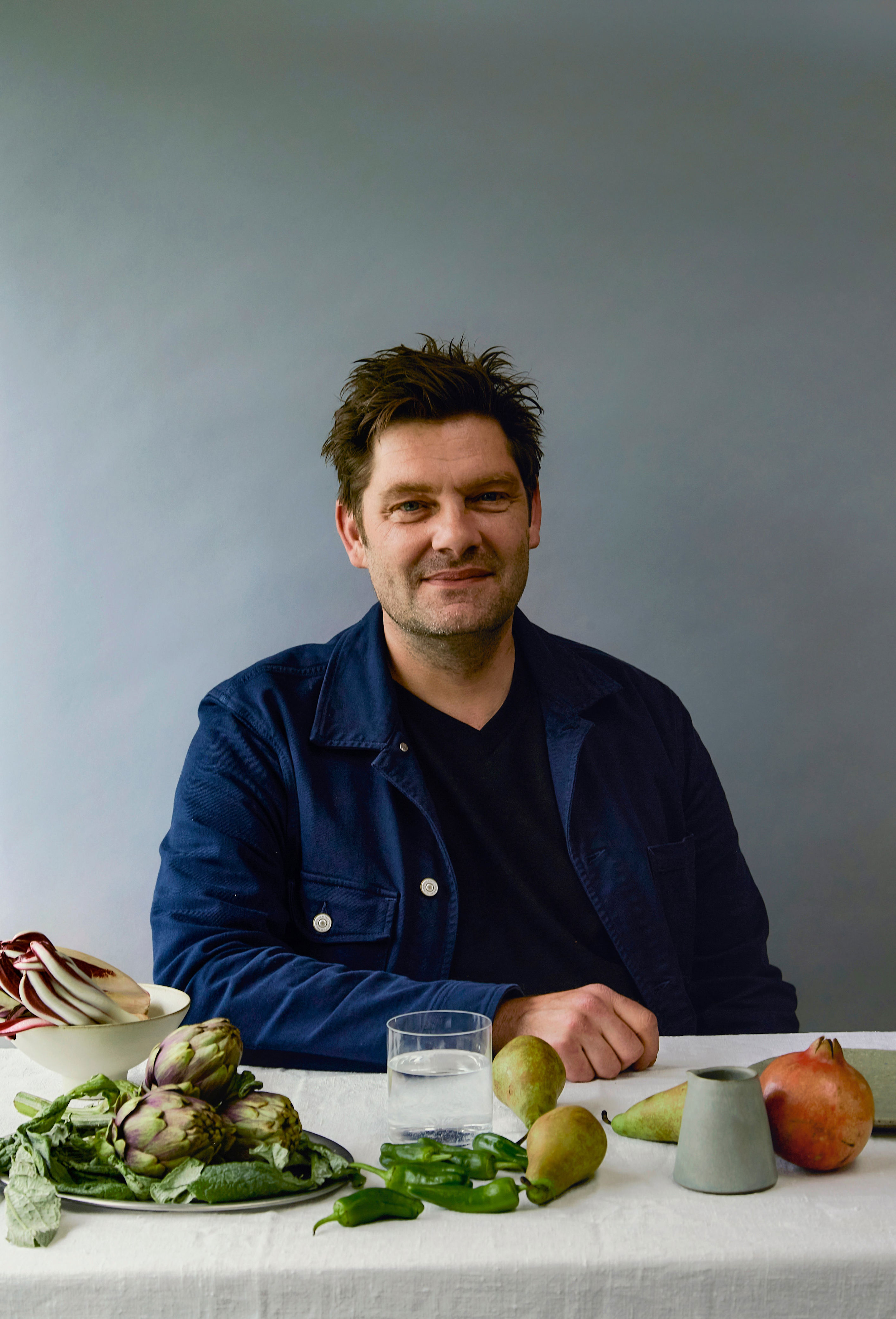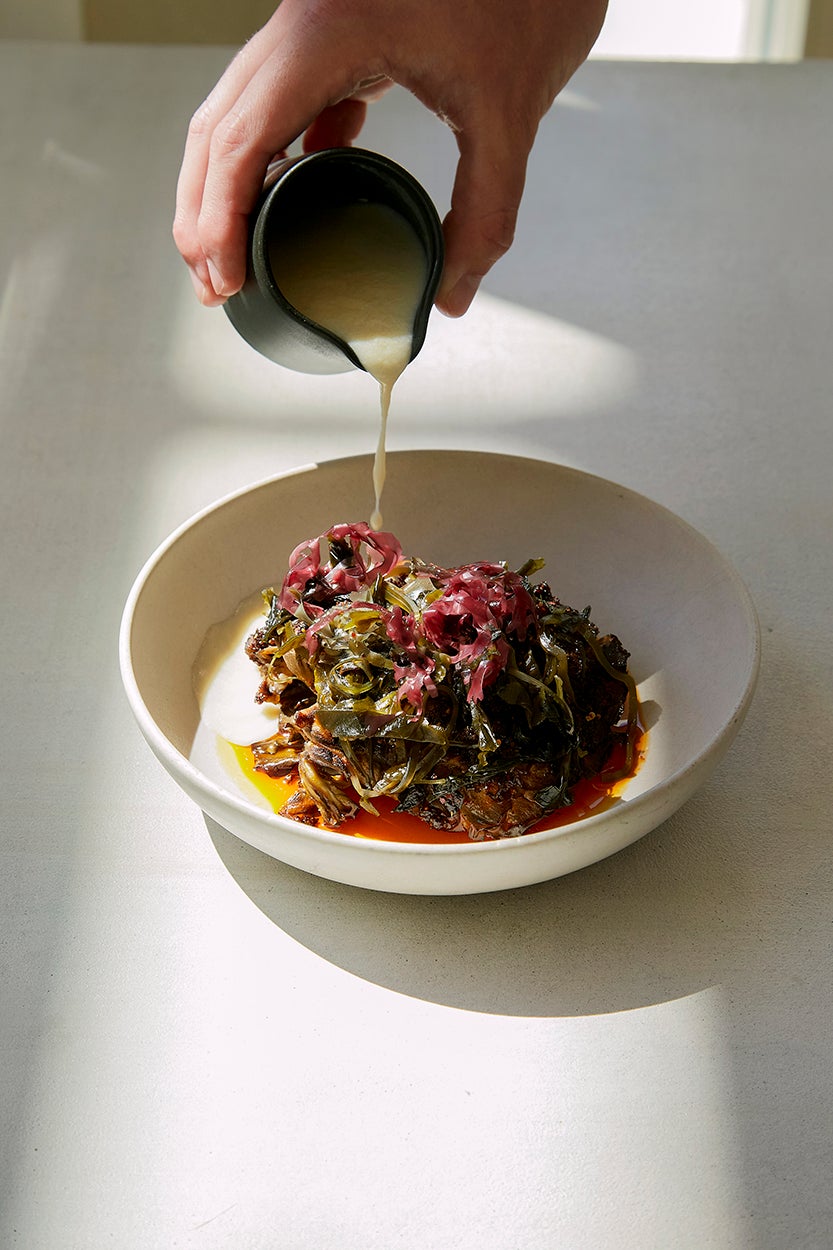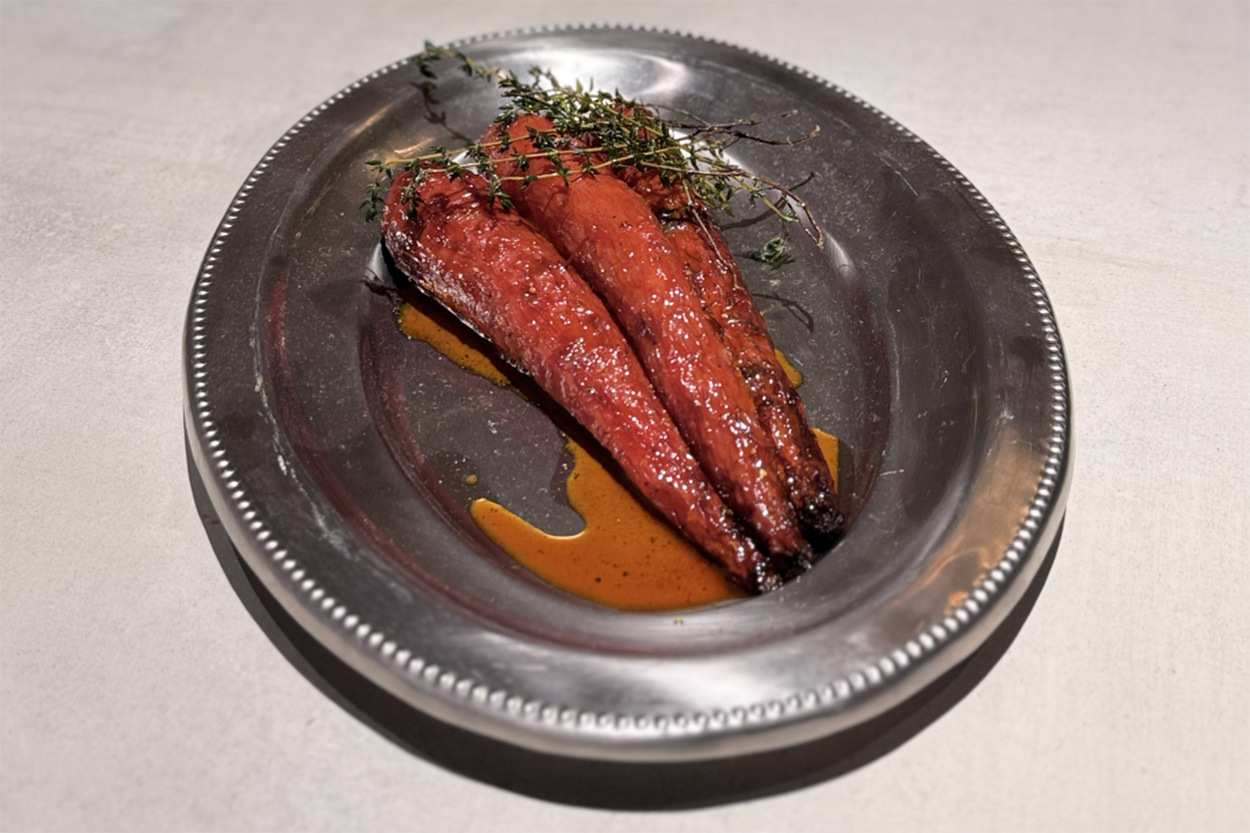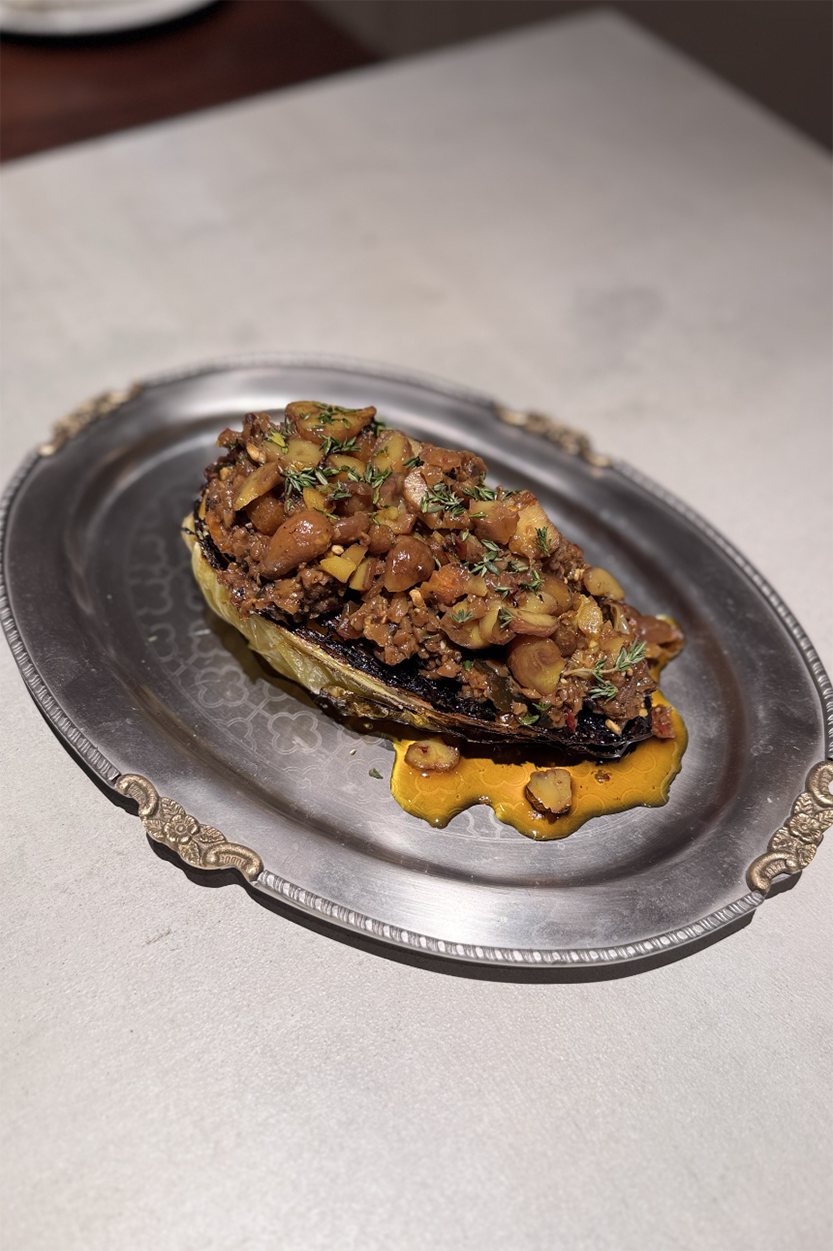has had a massive influence on my approach to cooking,” the executive chef at Holy Carrot, a plant-based restaurant in Notting Hill, tells me. “I grew up in the Eighties and Nineties, where vegetarian and vegan products were scarce – there was no Quron in sight.” His secret, then? “Highlighting the beauty of the vegetable itself.”
has defined Watkins’ career. He carved his name at Acme Fire Cult, a live-fire cooking concept where embers do the heavy lifting and where, incidentally, “the menu was made up of 60 per cent plant-based dishes”.
While a lick of flame might elevate even the humblest of vegetables, not every home cook experimenting with Veganuary will be inclined to fire up the barbecue on a miserable afternoon in January. In that case, “to get all that flavour, it’s about adding certain seasonings and caramelising the pan,” Watkins says. “The process of caramelisation can emulate that flavour profile quite well.” Try heating your pan until it’s almost smoking, then let vegetables like mushrooms or celeriac sit undisturbed until they develop those deeply golden edges. The key is patience – resist the urge to stir too soon, and you’ll be rewarded with restaurant-quality caramelisation.
loin mane and chips, served with a peppercorn sauce or miso gravy. It has the same texture, depth and prep time too.”
Seasonal eating is Watkins’ gospel. It’s when veg are not only at their tastiest but also easiest on the wallet. And for this winter, he’s betting big on some underrated stars. “Celeriac is one of the most underrated vegetables yet it’s so versatile. I love simply grilling it with a glaze, or if you’re feeling like a bit of a treat, panko crumb and fry for a crispy celeriac schnitzel.” He also gives a nod to calcots, a type of green onion that comes into season in January. “I’d recommend grilling them and serving with a simply classic romesco.”

His menus at Holy Carrot highlight the creativity that’s possible with plants. Like his hen of the woods with tofu soubise (French onion sauce) and mala (Sichuan seasoning) sauce – a dish that combines smoky mushrooms with creamy, buttery onions and a spicy kick. Or his roasted hispi cabbage with mushroom XO sauce, a plant-based spin on the classic Cantonese condiment. In fact, “building a pantry of flavourful dressings, seasonings and sauces definitely plays a big part” in making plant-based dishes vibrant and delicious. Start small with pantry staples. A good tahini dressing, a punchy romesco or a quick miso glaze can transform even the simplest veg into something spectacular. Watkins recommends using seasonal produce as your guide – think roasted calcots with romesco or winter tomatoes paired with a miso vinaigrette.”
Fermentation and preservation, in particular, are central to his approach. They “are actually both very simple processes and can easily be done at home,” he says. One of his favourites is garlic: “it’s as simple as adding a little salt and giving it time”. In the end, you’ll have an umami bomb that you can add to sauces, stews or even spread on toast.
waste, a cornerstone of his low-waste philosophy at Holy Carrot. “Sustainability is key and there are subtle ways to embrace these low-waste practices at home. One way is definitely buy local produce where possible, either from farmers markets or your local shops,” he says. “The second thing I’d say, which seems far-fetched but is a life saver, is to invest in a dehydrator. (You don’t have to buy a fancy one!) By saving your vegetable peelings and drying them out you can add them to stocks or bases of stews.” No dehydrator? No problem. Spread your peelings on a baking tray and dry them in a low oven until crisp, then blitz into a powder. Sprinkle it over soups or stews for a zero-waste flavour boost.
While his dishes are celebrated for their bold flavours, Watkins insists they’re not out of reach for the average home cook. “I take inspiration from the produce itself, what’s in season, and then I tend to cook the things I either grew up eating or love to cook at home,” he says. “This helps me not overcomplicate the recipe and ensure it’s accessible to all levels.”
easy and time sensitive to overcome this idea that eating plant-based is a challenge.” Like anything new in life, making a change can be intimidating. “Doing a weekly food plan and a weekly food shop will help with the transition and also make the everyday task of cooking seem less daunting,” says Watkins. “And if you’re struggling or feel uninspired, social media is full of easy, foolproof recipes.”
For those who are more seasoned in their plant-based journey, he challenges them to explore ingredients they might have overlooked – he’s fond of Iberiko tomatoes, which you’ll see on the Holy Carrot this January – or step out of their comfort zone. Ferment something – a quick pickled daikon adds zing to any dish – or try cooking with unusual grains like freekeh or teff for texture and depth.
Even the veg you swore you’d never touch – sprouts, we’re looking at you – can become something special with a bit of imagination. The grilled sprouts with maypo gravy and stracciatella, a star of the Holy Carrot menu, wasn’t always one of Watkins’ favourites. “Growing up I was never a big fan of sprouts, I was almost forced to eat them, so when I put this dish together and found my love for the vegetable it really felt like a full circle moment.” If Watkins can turn them into a menu star, surely they deserve a second chance.
Watkins knows better than anyone that it’s not about being perfect – it’s about giving it a go. And if there’s one thing he’s keen to emphasise, it’s that vegetables are far more versatile than we often give them credit for. He’s not here to preach, but he might just convince you to see celeriac in a new light or give those calcots their long-overdue moment in the sun.
Hen of the woods, tofu soubise, mala sauce

“This is one of my favourite dishes – it’s smoky meaty mushrooms, creamy buttery onions, all finished with a spicy kick.”
Soubise
:
3 medium white onions (approx 480g)
250g Flora plant butter (1 block)
2 tbsp Mirin (28g)
1 tbsp rice wine vinegar (15g)
1 block silken tofu (325g)
Salt to taste
:
1. In a pan, sweat the onions down with butter for over an hour until they go soft, golden and start to sweeten. Add a pinch of salt.
2. Deglaze the pan with mirin and rice wine vinegar, to loosen and dissolve any food away from the sides of the pan.
3. Leave to cool slightly, and then transfer all the ingredients to a blender, along with the silken tofu. Blend until completely smooth and add salt to taste.
: This recipe will make more than what you need for this dish, so anything left over – you can freeze for another time.
Mala sauce
: 20 servings (don’t panic at this volume. It’s absolutely worth making a larger amount as it keeps so well and is great on pretty much anything!)
:
180ml roasted peanut oil or good quality olive oil (not extra virgin)
1 tbsp fresh ginger, finely chopped
1 star anise
½ cinnamon stick
1 small shallot, finely chopped
1 small garlic clove, finely chopped
2 tbsp Sichuan peppercorns
20g dried chilies
60ml toasted sesame oil
:
1. Heat your choice of oil in a skillet over a low flame, until it reaches a temperature of around 175F/80C.
2. Add all of the spices and cook until the oil reaches a higher temperature of 225F/107C over moderately low heat.
3. Simmer at this temperature for 5 minutes.
4. Finally, pour the mixture into a heatproof jar and leave it to cool completely. Mix in the toasted sesame oil and enjoy!
Hen of the wood
:
Hen of the woods, approx 300g per person
4 thyme sprigs
1 lemon
2 cloves of garlic
100g butter
100ml olive oil
:
1. Add 50g of the butter and olive oil to a pan over medium heat. As it starts to melt and bubble, add the mushrooms and a big pinch of salt for seasoning. Let the mushrooms sit for 1 minute, basting the mushrooms with some of the butter and oil.
2. Add to the pan a couple sprigs of thyme, a clove of smashed garlic and a squeeze of lemon juice. Shake the pan to bind these ingredients together.
3. Let the mixture sit and continue to cook for 30 seconds.
4. When the mushrooms are completely cooked through and caramelised, allow to rest on a tray, then serve.
:
1. Prepare a wood fire. When the embers are nice and hot, about 30 minutes, rub the grill grates with the oiled rag, then grill the hens, turning every few minutes to brush them with them.
2. When the mushrooms are completely cooked through and caramelised , remove and serve.
Serving
1. Pour the warm soubise into the bowl, place the hen of the wood on top of the soubise, finally dress with the mala sauce.
Roast carrots

“Carrots roasted with this rub really come to life roasted in the oven, even better grilled over fire.”
:
30g whole black peppercorns
30g ground black pepper
15g whole coriander seeds
15g coriander powder
15g brown sugar
15g smoked paprika
2 tsp garlic powder
2 tsp onion powder
½ tsp whole mustard seeds
½ tsp mustard powder
:
1. In a dry pan, carefully toast all the whole seeds gently until aromatic, then stir in the powdered spices. Allow the mixture to cool completely.
2. Once cooled, grind the spice rub into a fine powder using a blender or spice grinder. Transfer to an airtight container for storage.
3. Blanch the carrots, before coating them evenly in olive oil.
4. Generously sprinkle with the prepared spice mix, then roast gently until they develop a nice, golden colour.
: Adding kombu dashi powder to the blanching water for your carrots add great flavour to them.
Roast hispi cabbage, mushroom XO

Mushroom XO
“A take on the classic XO, using mushrooms – delicious and very moreish!”
:
300g shiitake mushrooms (finely chopped)
120ml olive oil
60ml dark soy sauce
3 dried ancho chilis (broken and seeds removed)
3 garlic cloves (finely chopped)
1 shallot (finely chopped)
2 tbsp kombu seaweed (finely chopped) (can be found in most Asian supermarkets)
20g fresh ginger (grated)
Pinch black pepper
½ cinnamon stick
1 star anise
Splash of sesame oil
60ml Shaoxing rice wine (can be found in most Asian supermarkets)
:
1. Warm the oil in a pan over medium heat. Add the shallots, spices and garlic, and cook gently until softened and fragrant.
2. Add the shiitake mushrooms and sauté until they release their moisture. Stir in the soy sauce and let the mixture reduce for a few minutes. Remove the cinnamon and star anise at this stage, as their flavours will already be infused.
3. Continue cooking the mixture for 10-12 minutes, allowing the mushrooms to reduce and the sauce to thicken significantly.
4. For a polished texture, transfer the mixture to a blender or food processor. Pulse a few times until the mushrooms are broken down but still chunky.
Hispi cabbage
:
1 hispi cabbage (½ per person)
Olive oil
Splash of vinegar
Toasted sesame seeds
Freshly grated chestnut
:
1. Remove the larger outer leaves from the cabbage, then wash it thoroughly and pat it dry. Cut the cabbage in half and drizzle with a little olive oil. Season generously.
2. Place the cabbage cut-side down on a hot skillet or over an open fire. Cook until the surface is nicely caramelised. If the cabbage is large, transfer it to the oven and roast until tender.
3. Once cooked, drizzle with a splash of vinegar and generously spoon over the mushroom XO sauce.
4. Finish with a sprinkle of toasted sesame seeds or freshly grated chestnut for added texture and flavour.
Recipes by Daniel Watkins, executive chef at www.holycarrot.co.uk
.


Post a Comment
0Comments